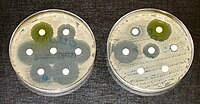
Photo from wikipedia
BACKGROUND The emergence of fluoroquinolone-resistant enterococci is worldwide. Antimicrobial resistance was characterized and the effect of quinolone-resistance factors was analyzed in high-level ciprofloxacin-resistant (HLCR) Enterococcus faecalis and Enterococcus faecium isolated… Click to show full abstract
BACKGROUND The emergence of fluoroquinolone-resistant enterococci is worldwide. Antimicrobial resistance was characterized and the effect of quinolone-resistance factors was analyzed in high-level ciprofloxacin-resistant (HLCR) Enterococcus faecalis and Enterococcus faecium isolated from fresh produce and fecal samples of patients. RESULTS Among the 81 ciprofloxacin-resistant Enterococcus isolates, 46 showed high levels of ciprofloxacin resistance, resistance to other quinolone antibiotics, and multidrug resistance profiles. The virulence factors esp and hyl were identified in 27 (58.7%) and 25 (54.3%) of isolates, respectively. Sequence type analysis showed that 35 strains of HLCR E. faecium were clonal complex 17. Eleven strains of HLCR E. faecalis were confirmed as sequence type (ST) 28, ST 64 and ST 125. Quinolone resistance-determining region mutation was identified in HLCR Enterococcus isolates; with serine being changed in gyrA83, gyrA87 and parC80. This result shows that gyrA and parC mutations could be important factors for high-level resistance to fluoroquinolones. CONCLUSION No significant differences were observed in antimicrobial resistance patterns and genetic characteristics among the isolates from fresh produce and fecal samples. Therefore, good agricultural practices in farming and continuous monitoring of patients, food and the environment for Enterococcus spp. should be performed to prevent antimicrobial resistance and enable reduction of resistance rates. © 2016 Society of Chemical Industry.
Journal Title: Journal of the science of food and agriculture
Year Published: 2017
Link to full text (if available)
Share on Social Media: Sign Up to like & get
recommendations!